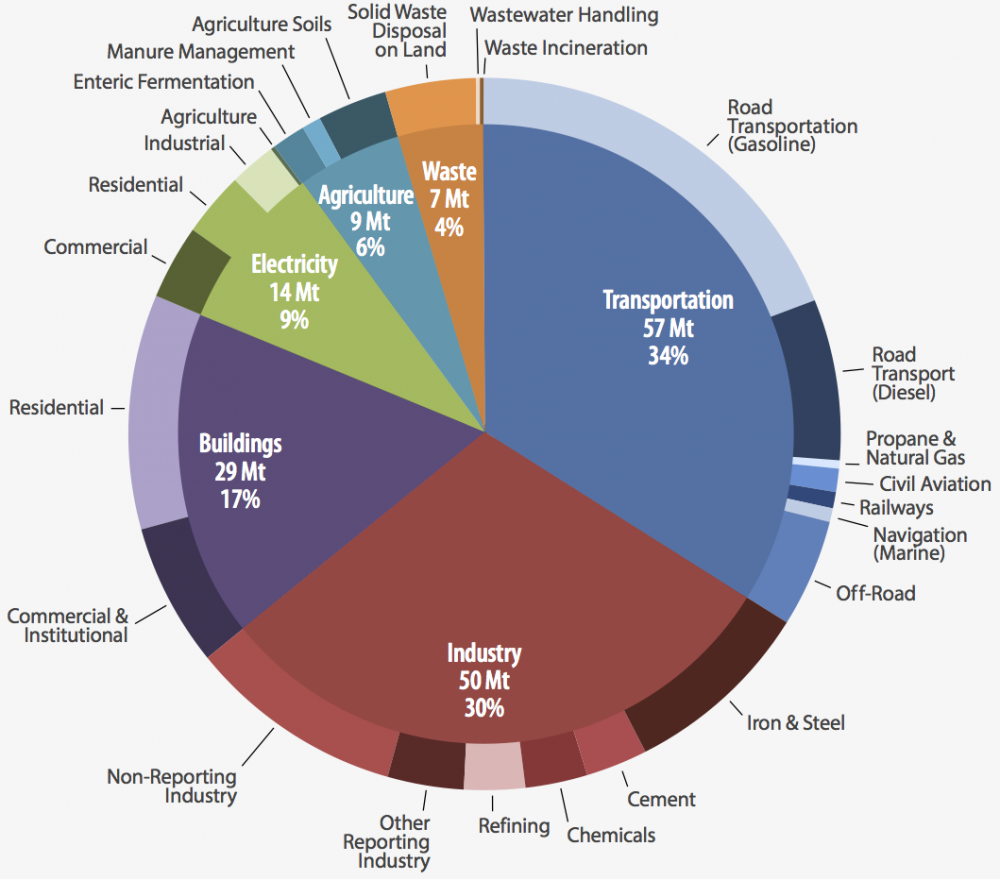
Yesterday the Ontario government released a new discussion paper to engage people across the province on climate change. It's great to see the provincial government tackling the climate challenge head-on, and talking about what we can do to address it.
Ontario’s coal phase-out is widely celebrated, and was critical in allowing the province to meet its 2014 climate target. In fact, it’s the single most effective climate policy introduced in Canada to date.
Now it’s time to build on that momentum so Ontario can meet its 2020 and 2050 climate targets. To succeed, the province will have to address its largest and fastest-growing source of carbon pollution: transportation.
Looking at the numbers
The transportation sector is currently responsible for 34 per cent of Ontario’s carbon pollution. That share is expected to rise to nearly 36 per cent by 2020.

Ontario’s current policies are projected to cut 42 megatonnes of carbon pollution by 2020. Of those reductions, 4.6 Mt will come from the transportation sector. That’s a problem: a sector that pumps out more than one-third of Ontario’s carbon pollution will only be contributing about one-tenth of its 2020 emissions reductions. Clearly, the transportation sector isn’t pulling its weight yet.
Making the Big Move
The Big Move, the regional transit plan for Greater Toronto and Hamilton, is the provincial policy that promises the largest cuts to carbon pollution from the transportation sector. It’s also significant at a national scale, ranking as number six in the list of Canada’s 10 most effective climate policies for meeting our 2020 climate targets.
It’s therefore critical that the Big Move is fully implemented. The province has already allocated $15 billion for investment in transit infrastructure in Greater Toronto and Hamilton over the next 10 years. That’s an excellent start, but the price tag for the full next wave of Big Move projects is $34 billion. Funding and building the entire plan — so that a truly interconnected regional network is put into place — is necessary in order to realize its full climate benefits.
Speeding things up
That being said, even if the Big Move stays on track, Ontario’s transportation emissions will continue to grow. It takes decades to build new rapid transit. To see results by 2020, we need more action and we need it quickly.
 The provincial government has announced that it will put a price on carbon — something we support wholeheartedly at the Pembina Institute. If Ontario’s approach effectively covers transportation fuels, that could help reduce vehicle emissions.
The provincial government has announced that it will put a price on carbon — something we support wholeheartedly at the Pembina Institute. If Ontario’s approach effectively covers transportation fuels, that could help reduce vehicle emissions.
But there are other options worth considering. A congestion charge in the Toronto region could cut carbon pollution while also reducing crippling traffic — it’s a climate policy that boosts productivity and saves drivers time and money. The trick is to develop a pricing mechanism that encourages mode shift, but doesn’t place an undue burden on drivers who don’t have a lower-carbon alternative.
That’s critical if the government wants to address the Greater Toronto Area’s congestion problem. A growing number of voices, from the Manning Foundation to University of Toronto engineers, are saying that simply building transit infrastructure is not enough. Road pricing is needed to actually make a dent in congestion — especially for a region projected to add three million residents by 2041.
Cleaner vehicles and freight
There was a time when the provincial government was striving to make one out of every 20 new passenger cars an electric vehicle. Thanks to the coal phase-out, Ontario's grid is a much lower-carbon source of energy for both public transit and private vehicles than fossil fuels, so the subject is worth revisiting. The province needs to consider strategies beyond costly rebates to increase the uptake of electric vehicles.
We'd also be remiss not to mention the freight sector. By switching fuel types and implementing solutions to move goods more efficiently, it's possible to significantly reduce emissions from freight trucks. Some goods could also be shifted to rail, which provides a significant benefit: freight trucks produce 12 times as much carbon pollution and are five times as emission-intensive as rail.
Insuring reductions
Looking beyond transportation infrastructure, there are other provincial policies that significantly impact the sector’s emissions. For example, the province’s plan to reduce car insurance premiums could result in more carbon pollution if it’s designed as an across-the-board reduction in the cost of driving. That would work against both the province’s climate and congestion goals.
A climate-smart approach to car insurance would introduce the “pay as you drive” model to Ontario, charging drivers based on the distance they travel. It’s a win-win policy that reduces premiums while also creating an incentive to cut pollution. This option is now available in 39 U.S. states, where it has produced an average cost savings of 10 to 15 per cent for drivers.
Planning wisely
Finally, traffic and tailpipe pollution are as much the result of land-use planning as they are of transportation planning. Ontario needs to ensure that when it builds new rapid transit lines, municipalities are surrounding them with compact, walkable developments that serve a range of family types and income levels.
Living near a rapid transit lines offers families the opportunity to give up one car and save $10,000 annually while dramatically cutting their transportation-related emissions. We can’t squander those kinds of opportunities with poor planning, such as building subways in areas that lack the policies to create compact, transit-oriented neighbourhoods.
Cherise Burda was Ontario director at the Pembina Institute until 2015.



